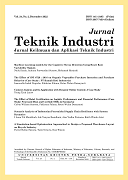A Simulation-based Optimization Approached to Design a Proposed Warehouse Layout on Bicycle Industry
DOI:
https://doi.org/10.9744/jti.24.2.141-150Keywords:
Facility planning , warehouse , class-based storage , dedicated storage , simulationAbstract
The finished goods must be stored in a warehouse before the items are dispatched. Due to the increasing demand in 2020, there will be an increase in the quantity of items, which will cause the finished goods warehouse at PT X to reach capacity. This issue lengthens the flow through the warehouse and makes it easier for the items to sustain damage. To improve capacity, the firm is building a new finished goods warehouse, and it wants to organize the two warehouses so that the displacement time is as short as possible. This study utilized simulations to calculate the time and dedicated and class-based storage strategies to establish the layout. This study utilized simulations to determine the time and dedicated and class-based storage approaches to establish the layout. According to the findings, the dedicated storage technique has a total displacement distance of 703,952 meters and an average moving duration of 3.37 minutes per pallet. These findings are not as useful as the class-based storage technique, which has 705,961 meters and an average pallet turn time of 3.53 minutes.
Downloads
References
Kembro, J., Eriksson, E. and Norrman, A., Sorting Out the Sorting in Omnichannel Retailing, Journal of Business Logistics, 43(4), 2022, pp.593-622, doi: 10.1111/jbl.12305.,
Faber, N., De Koster, R.B. and Smidts, A., Survival of the Fittest: The Impact of Fit between Warehouse Management Structure and Warehouse Context on Warehouse Performance, International Journal of Production Research, 56 (1-2), 2018, pp. 120-139. doi: https://doi.org/10.1080/00207543.2017.1395489
Mourtiz D, Samothrakis V, Zogopoulos V, Vlachou E. Design and Operation using Augmented Reality Technology: A Papermaking Industry Case Study. 12th CIRP Conference on Intelligent Computation in Manufacturing Engineering, 18-20 July 2018, pp. 574-578.
Ozturkoglu, O., Gue, K. R., and Meller, R. D., A Constructive Aisle Design Model for Unit-load Warehouses with Multiple Pickup and Deposit Points. European Journal of Operational Research, 236(1), 2014, pp. 382–394.
Nantee, N. and Sureeyatanapas, P., The Impact of Logistics 4.0 on Corporate Sustainability: A Performance Assessment of Automated Warehouse Operations, Benchmarking: An International Journal, Vol. ahead-of-print (ahead-of-print), 2021 doi: 10.1108/BIJ-11-2020-0583.
Nieuwenhuyse, V., and De Koster, R. B., Evaluating Order Throughput Time in 2-block Warehouses with Time Window Batching. International Journal of Production Economics, 121(2), 2009, pp. 654-664. doi: 10.1016/j.ijpe.2009.01.013.
Pan, J. C.-H., Shih, P.-H., and Wu, M.-H. Storage Assignment Problem with Travel Distance and Blocking Considerations for a Picker-to-part Order Picking System. Computers & Industrial Engineering, 62(2), 2021, pp. 527-535. doi:10.1016/j.cie.2011.11.001
Sari, T.P., Ridwan, A.Y., and Aurachman, R., Designing Floor Tile Warehouse Layout Using Heuristic Approach Method to Increase Warehouse Capacity and Reduce Travel Distance, International Journal of Innovation in Enterprise System, 1(1), 2017, pp.44-52.
Gong, D.C., Sooksaksun, N., and Kachitvichyanukul, V., A Class-Based Storage Warehouse Design using a Particle Swarm Optimization Algorithm, International Journal of Operational Research, 13, 2012, pp. 219-237. doi:10.1504/IJOR.2012.045188.
Dukic, G. and Tihomir, O., Warehouse Layouts, Warehousing in the Global Supply Chain: Advanced Models, Tools and Applications for Storage Systems, 2014, pp. 55-69. doi:10.1007/978-1-4471-2274-6_3.
Tiwari, S., Dixit, S., Kumar, V., and Rastogi, A., Analogy among Center of Gravity, Center of Mass, and Centroid of Rigid body: Analysis of Formula for Their Respective Calculation as per Configuration of Body and Utilization in Composite Application, Applied Functional Materials, 2(2), 2022, pp. 7-13. Doi: 10.35745/afm2022v02.02.0002.
Tellez, G., and Sarrafzadeh, M., On Rectilinear Distance-Preserving Trees, VLSI Design, 7(1), 1998,pp. 163 – 166, doi: 10.1109/ISCAS.1995.521476.
Dianto, C., Widiandoko, F., Rahmanasari, D., Yuniaristanto, and Sutopo, W., Redesign Production Layout Using Dedicated Storage Method: Case Study of PT.Solo Grafika Utama. IOP Conference Series: Materials Science and Engineering, 943, 012042, 2020.
doi:10.1088/1757-899X/943/1/012042.
Gozali, L., Marie, I.A., Natalia, Kustandi, G.M., Adisurya, E., Suggestion of Raw Material Warehouse Layout Improvement Using Class-Based Storage Method (case study of PT. XYZ), IOP Conf. Series: Materials Science and Engineering, 1007, pp. 1-10, 2020
Yu, Y., Koster, D., René, Guo, X., Class-Based Storage with a Finite Number of Items: Using More Classes is not Always Better, Production and Operations Management, 24(8), 2015, pp. 1235-1247. doi:10.1111/poms.12334.
Rao, S.S. and Adil, G.K. Class-based Storage with Exact S-shaped Traversal Routeing in Low-Level Picker-to-Part Systems, International Journal of Production Research, 51, 2013, pp. 4979–4996. doi: 10.1080/00207543.2013.784419
Downloads
Published
How to Cite
Issue
Section
License
Articles published in the Jurnal Teknik Industri: Jurnal Keilmuan dan Aplikasi Teknik Industri will be Open-Access articles distributed under the terms and conditions of the Creative Commons Attribution License (CC BY).
![]()
This work is licensed under a Creative Commons Attribution License (CC BY).



















